Downtown Seattle is full of apartment buildings overlooking Elliott Bay, with frequent ferry and commercial traffic. If a distress flare were fired in this area, you would expect this to generate a lot of reports. But when one was set off on a recent Tuesday morning, we might have been the only ones to report it.
We happened to glance out the window at 6:40am and saw what looked like a small boat, lit only with an orange light, move southward across Elliott Bay. Orange is an unusual color, and through binoculars we could see it was a parachute distress flare, pictured above under the red arrow. The light moved slowly up and away from us, over Duwamish Head in West Seattle.
With several ferries underway in the area at the time, plus a few commercial boats at anchor, we expected the flare would be reported. But we called it in to the Coast Guard just in case. We also listened by VHF radio to see if anyone else reported it. We heard the Coast Guard contact Vessel Traffic to ask if anyone had reported it, and subsequently Vessel Traffic speaking with the vessels that were in the area, but no-one had seen or reported anything. The Coast Guard also broadcast a PAN-PAN on VHF channel 16, reporting the incident and asking for more information, with no response.
At 6:50, about ten minutes after our report, the Coast Guard called back to try to determine the source and trajectory of the flare. They asked James for the height of our apartment and asked him to sight along his arm at various angles. They concluded the flare likely was set off in the vicinity of Duwamish Head in west Seattle, directly across Elliott Bay from our apartment. At 7:30, a small Coast Guard boat departed the base along the Seattle waterfront and sped across to Duwamish Head to search the area.
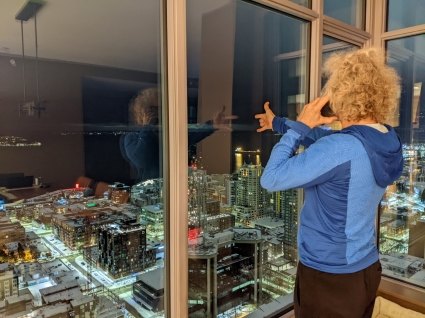
|
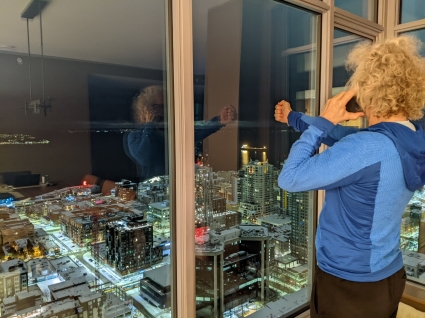
|
| James following Coast Guard direction to gauge the source and trajectory of the flare. | |
Shortly after sunrise at 8:40am, a Coast Guard helicopter searched the area on our side of Elliott Bay. And later at 10:00am a small boat arrived and appeared to be searching as well. As far as we know, nothing was found and the flare likely was a false alarm.
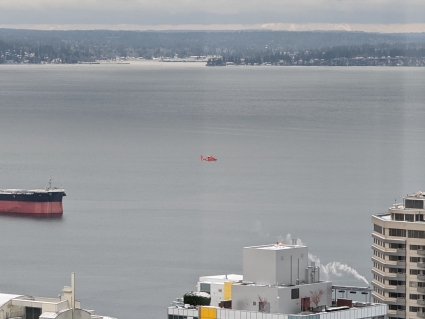
|
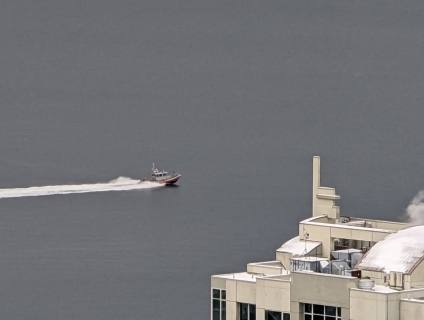
|
| Coast Guard helicopter and small boat searching the Seattle waterfront after daylight. | |
This is the second time we’ve seen and reported a flare in the Seattle area. The previous time was from an anchorage in Eagle Harbor, a busy port directly across Puget Sound from Seattle. Houses surrounded the shore and perhaps 200 vessels filled the harbor that night. Yet when a parachute flare lit the sky, the only reports to the Coast Guard were from a ferry and from us. And even with our immediate reports, an emergency crew took 20 minutes to arrive.
Both incidents underline how important self-reliance is for boaters. Emergencies seldom occur so close to such a well-equipped Coast Guard station. And just because people are nearby doesn’t mean anyone will notice someone in distress.
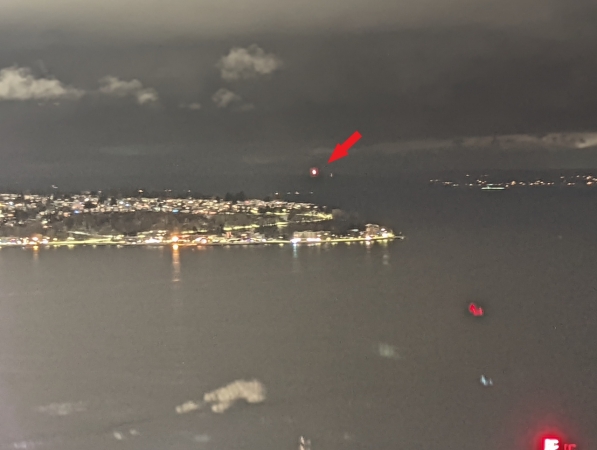
It was very cool to see this from the other perspective. I’ve been following along on your blog for about ten years at this point and I’m also a Coast Guard helicopter pilot that flies for these kinds of calls quite frequently. Your observations are absolutely correct in that a response can take a lot of time and that a flare can very easily go unnoticed. It takes us about 30min to get the helicopter launched and depending on the location a significant amount of time to get there. Every bit of information that you provided is useful, as is communicating your level of experience and certainty about what you saw.
To your point about self reliance I agree that it’s absolutely critical, and I would add that having multiple ways of signaling distress is vital. To me as a helicopter pilot a flare is great to help me find you once I’m already out there looking, but without something more reliable like an EPIRB chances are high we will never even know to start looking.
When people ask me about being safe on the water the most vital things I recommend are these.
1. Give a detailed float plan to a trusted individual. Be specific and directive. “I will check in with you at 130, if we have not talked by 2, call the coast guard at this number”. Make sure to emphasize the importance of not hesitating to start the SAR process.
2. Bring and wear a life jacket.
3. Carry a PLB. If I’m on the water with my family we wear life jackets on deck at all times and each of those vests has a GPS enabled PLB.
4. Carry a signaling device. My preference is a SOLAS water activated strobe on every vest. It doesn’t take much, but you have to have something. I once spotted a distressed individual signaling with a cigarette lighter at more than 8 miles out, but we were out there because someone knew they should be home and called us.
I could go on and on about the safety steps and equipment that actually move the needle when things go bad, but those are the basics I toss out to people that ask, and I know those are things you both already practice and preach!
Thank you for being an attentive member of the maritime community and calling us when you see these, and for providing us all with such quality content for so long!
It’s extremely cool to hear from a rescue helicopter pilot. I can’t imagine flying near wave tops at night in horrendous winds while try to get a rescue swimmer positioned to help someone in trouble. Thanks for all you and your crews do.
I’m guessing that the CG seldom has civilians out even on practice missions but, were it possible, we would jump on the opportunity to document what you do. Some years back I did have the privilege of heading out for a dive on the USS California off the coast of Florida: https://mvdirona.com/2016/05/uss-california-distinguished-visitor-embark/. Just amazing.
Pass on our thanks to your full crew and we appreciate the feedback on the blog.
Thanks! I’m currently stationed on the Great Lakes, but if I end up stationed out your way I would absolutely have you guys out for a tour. I love sharing what we do!
If you find yourselves in Detroit let me know! I would equally love to pick your brain on all things nordhavn as that’s in our plans as well.
Brian, most of what you write is ‘common sense’ (wear PFD, file a float plan, carry signaling device, etc) – but it is SO GOOD to hear it from a professional at the ‘other end’ of what I guess often sadly are very tragic events. I cannot fathom how it is being up there in a chopper and miraculously finding persons or vessels out in the ocean. Something likely often harder than finding the venerable needle in the haystack.
Growing up in Sweden, we were taught from an early age to always wear a PFD when out on the water (this was pre-PLBs). I always remember one of the PSAs on TV, highlighting that most drownings happened not during inclement weather out at sea, but on very calm inland lakes when people were out fishing (w/o PFDs).
As for James, I have been fortunate to not only follow him for years, but also getting to meet him once last fall here in town. His (or rather their) writings are endlessly interesting, on topic, accurate, informative, and often allows us to ‘travel in their foot steps’.
Thanks for the feedback on the blog Per-Ola.
Absolutely, I often preach the basic safety stuff to people that usually respond “I always stay close to shore.” The unfortunately grim reality of what I do is that most people are killed on beautiful calm days within a mile of shore. Glad to hear you also preach the basics!